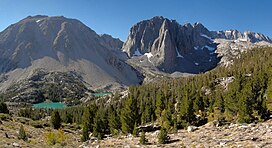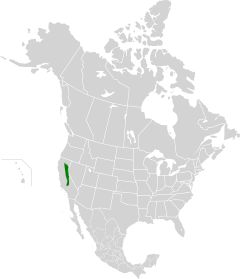- See Sierra Nevada for general information about the mountain range in the United States.
| Sierra Nevada forests | |
|---|---|
 Subalpine forest at the base of Temple Crag | |
 | |
| Ecology | |
| Realm | Nearctic |
| Biome | Temperate coniferous forests |
| Bird species | 197[1] |
| Mammal species | 103[1] |
| Geography | |
| Country | United States of America |
| State | California, Nevada |
| Conservation | |
| Global 200 | Yes |
| Habitat loss | 1.0785%[1] |
| Protected | 72.55%[1] |
The ecology of the Sierra Nevada, located in the U.S. states of California and Nevada, is diverse and complex. The combination of climate, topography, moisture, and soils influences the distribution of ecological communities across an elevation gradient from 500 to 14,500 feet (200 to 4,400 m). Biotic zones range from scrub and chaparral communities at lower elevations, to subalpine forests and alpine meadows at the higher elevations. Particular ecoregions that follow elevation contours are often described as a series of belts that follow the length of the Sierra Nevada.[2] There are many hiking trails, paved and unpaved roads, and vast public lands in the Sierra Nevada for exploring the many different biomes and ecosystems.[3]
The western and eastern Sierra Nevada have substantially different species of plants and animals, because the east lies in the rain shadow of the crest. The plants and animals in the east are thus adapted to much drier conditions.[4]
The altitudes listed for the biotic zones are for the central Sierra Nevada. The climate across the north–south axis of the range varies somewhat: the boundary elevations of the biotic zones move by as much as 1,000 feet (300 m) from the north end to the south end of the range.[4]
- ^ a b c d Hoekstra, J. M.; Molnar, J. L.; Jennings, M.; Revenga, C.; et al. (2010). Molnar, J. L. (ed.). The Atlas of Global Conservation: Changes, Challenges, and Opportunities to Make a Difference. University of California Press. ISBN 978-0-520-26256-0.
- ^ Storer, Tracy Irwin; Usinger, Robert Leslie (2004-09-01). Sierra Nevada Natural History. p. 20. ISBN 978-0-520-24096-4.
- ^
 This article incorporates public domain material from "Vegetation Overview". Yosemite National Park. National Park Service. Retrieved 2009-10-25.
This article incorporates public domain material from "Vegetation Overview". Yosemite National Park. National Park Service. Retrieved 2009-10-25.
- ^ a b Schoenherr, Allan A. (1992). A Natural History of California. University of California Press. ISBN 0-520-06922-6.